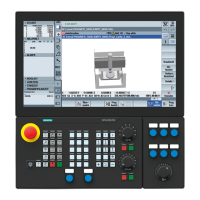Oscillation
11.2 Oscillation controlled by synchronized actions (OSCILL)
Job planning
Programming Manual, 07/2010, 6FC5398-2BP40-0BA0
639
11.2 Oscillation controlled by synchronized actions (OSCILL)
Function
With this mode of oscillation, an infeed motion may only be executed at the reversal points or
within defined reversal areas.
Depending on requirements, the oscillation movement can be
● continued or
● stopped until the infeed has finished executing.
Syntax
1. Define parameters for oscillation
2. Define motion-synchronous actions
3. Assign axes, define infeed
Meaning
OSP1[<oscillating axis>]=
Position of reversal point 1
OSP2[<oscillating axis>]=
Position of reversal point 2
OST1[<oscillating axis>]=
Stopping time at reversal point 1 in seconds
OST2[<oscillating axis>]=
Stopping time at reversal point 2 in seconds
FA[<oscillating axis>]=
Feed for oscillating axis
OSCTRL[<oscillating axis>]=
Set or reset options
OSNSC[<oscillating axis>]=
Number of sparking-out strokes
OSE[<oscillating axis>]=
end position
WAITP(<oscillating axis>)
Enable axis for oscillation
Axis assignment, infeed
OSCILL[<oscillating axis>]=(<infeed axis 1>,<infeed axis 2>,<infeed
axis 3>)
POSP[<infeed axis>]=(<end position>,<partial length>,<mode>)
OSCILL: Assign infeed axis or axes for oscillating axis
POSP: Define complete and partial infeeds (see the "File and Program
Management" chapter)
End position: End position for the infeed axis after all partial infeeds have been
traversed.
Partial length: Length of the partial infeed at reversal point/reversal area
Mode: Division of the complete infeed into partial infeeds
= Two residual steps of equal size (default);
= All partial infeeds of equal size

